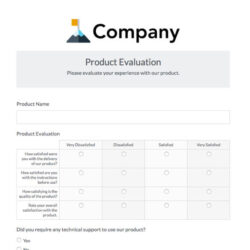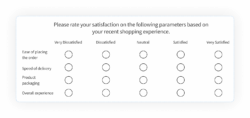Ever found yourself needing quick, digestible feedback on something? Whether it is about a recent customer interaction, a new product feature, or even the effectiveness of an internal training session, getting a clear picture fast is often key. That is where the humble but mighty 1 to 10 scale comes into play. It is intuitive, universally understood, and incredibly versatile, making it a go-to choice for capturing sentiment without overwhelming respondents.

This simple numerical range allows people to quickly express their feelings or opinions, transforming complex feedback into easily quantifiable data. From gauging satisfaction levels to assessing perceived quality, leveraging a structured approach can streamline your data collection. In this article, we will explore why a well-designed scale of 1 to 10 survey template is such a powerful tool and how you can use it to gain valuable insights effectively.
Understanding the Power of the 1-10 Scale for Feedback
The ubiquity of the 1 to 10 scale is no accident. Its simplicity is its greatest strength, offering a straightforward way for respondents to express their degree of agreement, satisfaction, or likelihood without needing to write lengthy explanations. This low cognitive load encourages higher response rates and provides cleaner data, which is crucial for making informed decisions. It transcends language barriers and cultural nuances, as the concept of a numerical spectrum from low to high is almost universally understood.
Think about its applications: from rating movie experiences on streaming platforms to evaluating service quality at a restaurant. Businesses across every sector, from small startups to multinational corporations, rely on this method for quick and efficient sentiment capture. It is particularly effective for tracking changes over time, as the consistent numerical scale allows for easy comparison of data points before and after specific interventions or changes. This longitudinal tracking helps in understanding trends and the long-term impact of strategies.
One of the key advantages of a 1-10 scale is the granularity it offers compared to a simpler 1-5 scale. While both are effective, the broader range of a 1-10 scale allows respondents to express more nuanced differences in their opinions. For instance, an 8 might indicate “very good” while a 9 could mean “excellent,” providing a subtle but important distinction that a 1-5 scale might compress into a single “good” category. This extra detail can be vital when trying to fine-tune offerings or pinpoint areas for marginal improvement.
Moreover, the data collected from a 1-10 scale is inherently quantitative, making it incredibly easy to analyze using statistical methods. You can calculate averages, medians, and modes to get a quick summary of overall sentiment. Beyond simple averages, you can segment your data by demographics or other factors to uncover specific insights, such as how different customer groups perceive your product or service. This analytical ease is why organizations find a well-structured scale of 1 to 10 survey template so invaluable for their feedback loops.
Crafting Effective 1-10 Scale Questions
- Be clear and concise with your questions. Avoid jargon or complex sentence structures.
- Clearly define what ‘1’ and ’10’ represent. For example, ‘1 = Not at all satisfied’ and ’10 = Extremely satisfied.’
- Focus on one specific aspect per question to avoid confusion.
- Consider adding an optional comment box for qualitative insights to complement the numerical data.
Putting Your Scale of 1 to 10 Survey Template to Work
Creating a survey is one thing; deploying it effectively and extracting meaningful insights is another. A robust scale of 1 to 10 survey template acts as your blueprint, ensuring consistency in your questioning and simplifying the setup process. It allows you to replicate successful survey structures across different campaigns or departments, saving valuable time and effort. Instead of starting from scratch every time you need feedback, you can simply adapt an existing, proven framework to your current needs.
When preparing to use your template, think about the channels through which you will distribute your survey. Email campaigns, website pop-ups, social media posts, or even QR codes at physical locations are all viable options. The chosen channel should align with where your target audience is most accessible and comfortable providing feedback. Ensuring the survey is mobile-friendly is also paramount in today’s digital age, as many respondents will likely complete it on their smartphones.
Beyond distribution, consider how you will collect and store the data. Most online survey platforms offer robust data collection and export features, allowing you to easily transfer your responses into spreadsheets or analytical tools. This is where the true power of a quantifiable scale shines, as the numerical data from your scale of 1 to 10 survey template is perfectly suited for charting trends, identifying outliers, and performing comparative analysis with ease and precision.
Finally, the most critical step after gathering responses is acting on the feedback. Raw data, no matter how perfectly collected, is useless if it just sits there. Analyze the trends, identify areas of strength and weakness, and formulate actionable strategies based on what your audience has told you. Whether it is improving a customer service process, refining a product feature, or enhancing employee training, the insights gleaned from your 1-10 scale survey can drive significant improvements and foster a culture of continuous learning and betterment within your organization.
In essence, the simplicity and power of a 1 to 10 scale make it an indispensable tool in any feedback collection arsenal. It offers a quick, clear, and quantifiable way to understand perceptions, measure satisfaction, and gauge the effectiveness of various initiatives. By embracing this straightforward yet profound method, you are not just collecting numbers; you are gathering voices.
Leveraging these insights empowers you to make data-driven decisions that resonate with your audience, leading to improved experiences, stronger relationships, and ultimately, greater success in your endeavors. So go ahead, structure your questions, define your scale, and unlock a world of valuable feedback awaiting your interpretation.


